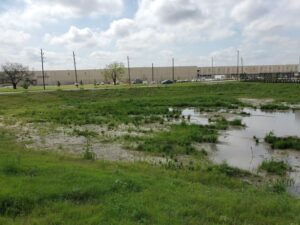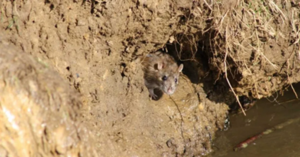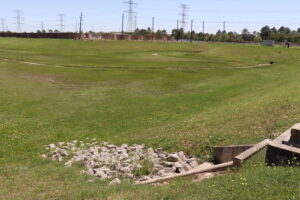Detention Pond Maintenance & Mowing
Detention Pond MaintenanceCommercial Property Detention Pond Maintenance

As a commercial property owner or manager, it would seem counterintuitive to spend time and money maintaining, for all intents and purposes, a hole in the ground that doesn’t generate any income.
Let’s face it, in the eyes of ownership, detention ponds are a necessary evil at best and a money pit at worst!
This is further evidenced by how often customers ask if our Houston detention pond maintenance team can just fill in the detention pond and forget it ever existed.
Unfortunately, the answer is no; we can’t. The reasons are numerous, but most importantly, detention ponds serve to mitigate downstream flooding.
And while eliminating the detention pond won’t necessarily flood your property, it could flood our downstream neighbors in Galveston and Brazoria counties.
Why Should You Maintain A Detention Pond?
 Why maintain it at all? Maintenance is costly. And it’s not like the detention pond on your property is a water feature. It doesn’t help sell/lease more property, does it? Probably not.
Why maintain it at all? Maintenance is costly. And it’s not like the detention pond on your property is a water feature. It doesn’t help sell/lease more property, does it? Probably not.
But if the detention pond is not maintained, unwelcome pests like mosquitoes and rats (yes rats!) may take up residence. And there’s also the issue of permit compliance that our detention pond maintenance company in Houston can assist with!
This situation invites snakes and other undesirable critters to your property which can undoubtedly affect your ability to keep tenants.
And suppose your detention pond serves a dual purpose as both detention and stormwater quality. In that case, you will need to provide photos in conjunction with the annual re-permit process showing that the pond is being maintained.
But regular maintenance doesn’t have to be costly. You can correct minor deficiencies before they become expensive repairs by performing scheduled detention pond maintenance with our Houston team.
We all know that an ounce of prevention is worth a pound of cure. That adage holds especially true regarding detention pond maintenance from our Houston area experts!
The Goal for Properly Maintaining a Detention Pond
The goal of detention pond maintenance from our Houston company is to keep the pond in “As-built” condition based on the construction drawings. Detention ponds are designed with a few conditions in mind:
1. Pond slopes should be no more than 3/1, meaning a 3 ft. horizontal run to a 1 ft. vertical. For perspective, think of a set of stairs with a 1/1 slope. This slope allows grasses and other vegetation to stay on the slopes (the vegetation keeps the soils on the slope from washing out). Additionally, a 3/1 slope allows for safe mowing conditions for commercial landscaping equipment.
2. Detention ponds should remain dry between rain events. The pond floor needs to be graded to drain to the outfall. Although this seems like common sense (water drains downhill), you might be surprised at how often we see brand-new improperly graded detention ponds.
3. Detention ponds should have a maintenance berm. This is just a fancy way of saying that there should be a flat area about 15 ft. wide around the entire detention pond. This area should be free of trees and shrubs, allowing tractors and other large maintenance vehicles to access the detention pond for maintenance. The maintenance berm is critical if your pond has a lift station or trash screen, as these features are quite heavy and require large equipment to repair or replace.
4. Detention pond slopes are properly stabilized before transfer to the owner. This is the most often overlooked piece of the puzzle. There are many challenges for the general contractor when attempting to get grass to grow on both the detention pond slopes and floor. But the slopes are especially problematic because the typical specification for the construction of detention ponds is to dig the hole and spray paper hydromulch. The mix for this hydraulically applied grass seed consists of paper mulch, seed, and fertilizer. Without any added tackifiers (glue), it has a tendency to wash off of the pond slopes during rain events. Since this basic hydromulch is the specified product, many of the detention ponds in Texas are out of compliance.
How To Achieve A Well Maintained & Compliant Detention Pond

The good news is that detention pond maintenance in Houston isn’t very difficult or costly. And for property managers, detention pond maintenance can be broken down into a monthly cost, so maintenance can be easily included in your budget.
But before a maintenance program can be implemented, the detention pond needs to be in good condition.
Assuming that there is no erosion on the slopes, a good stand of grass is present, and the floor is fully vegetated and dry between rain events; we can begin a sustainable maintenance program consisting of:
1. Monthly mowing: Why monthly? First, let’s consider the growth rate of grasses. In Texas, we see a growth of up to 16 inches/month at the height of the growing season. Using commercial zero-turn or walk-behind mowers, we can mow a 12-inch stand of vegetation at 4 mph.
As the grass grows taller, the speed at which our retention basin mowing team in Houston can mow decreases substantially. A 24-inch stand of grass can be mowed at 3 mph, 36 inches at 2 mph, and 48 inches at 1 mph.
As you can see, the time required to mow doubles every 12 inches, and so too does the cost. In this example, based on time spent, we can mow the same pond every 4 months (4 mows/yr.) for the same price as mowing monthly.
Keep in mind that root growth is our number one goal here. We need those roots to hold the soil in place. So a thick, healthy root structure is more important than tall vegetation.
Each grass blade contains hormones that suppress horizontal growth. These root tips are removed when the grass is cut, allowing the grass to spread and grow thicker root structures.
Additionally, mowing equipment blade heights need to be set as high as possible. The max blade height in a commercial zero turn mower is 6 inches. Remember, the purpose of this mowing is not to beautify the site but to sustain the vegetation and create a healthy root zone. Let’s consider that a grass blade is simply an elongated leaf necessary for photosynthesis.
It stands to reason that if we defoliate the plant by mowing, the plant will expend most of its energy replacing these necessary food factories. If we leave the blades long, the plant can focus on root growth. And it’s deep roots that keep the grasses healthy during stressful heat and/or drought conditions.
This is why, in the heat of the summer, some detention ponds look healthy while others have vegetation that is brown and withering. The reason is that the roots aren’t deep enough to capture the little bit of moisture in the subsoils.
2. Fertilizer: Again, it seems counterintuitive to stimulate growth in the detention pond that we are trying not to spend any money on. But fertilizing at a minimum twice/year is critical to maintaining turf grasses.
These fertilizer applications help promote healthy vegetation with a deep, dense root system that holds the soils in place. This recommendation is based on Texas A&M guidance for fertilizer application of turf grasses in Texas. In the case of detention ponds, the slopes are of the most concern.
When it rains, water drains down the slope, stripping nutrients off the slope to the pond floor where they can settle out. Therefore, fertilizing the pond floor is rarely necessary.
And also why fertilizing the slopes is so essential. For this reason, our detention pond maintenance team in Houston focuses on fertilizing only the slopes, a considerable cost saving compared to fertilizing the entire pond.
You Don’t Need To Go It Alone
Other than regular fertilizing and retention basin mowing from our Houston team, the only other concerns are repairing any slope degradation and removing sediment from pilot channels to allow for proper drainage.
These deficiencies usually happen slowly, which means they can be caught and corrected before things get out of hand and become costly repairs. This is why monthly inspections are so important.
Maintaining detention ponds and keeping our customers in compliance is what we do. Let our detention pond maintenance company in Houston provide you with a complimentary site assessment to assist you with all of your detention pond and stormwater quality needs.
